If you’re new to this rock-collecting hobby then you’ll need to understand there are more gems, minerals, crystals, and specimens than you can possibly count or remember. However, you’ll naturally fall in love with the ones that intrigue you the most. More than likely it will be the crystal structure, the configuration of the crystals, or the vibrant color that drives your passion for the stone.
One great tool to use as a beginner rockhound is my “How to Identify” series. You can search for the stone or mineral you believe you have in your possession and apply the guided activity for identifying your rock or mineral. If you run into any issues or you narrow it down to two stones then contact me directly and I’ll help you finalize the identification.
Here’s one last resource everyone should take advantage of, your local rock and mineral show. These are held once a year and provide a great opportunity to expose yourself to hundreds of rocks, minerals, gems, and crystals. I believe you’ll learn more about this hobby at rock shows than you can learn in a class. Plus they’re typically free and loads of fun.
If you’re not sure how to find your local rock and mineral club then use the “explore by state” page to locate your state and club.
Names of Green Minerals and Crystals
I’ve spent years digging for rocks and minerals in the lower 48 states plus attending the Tucson Gem and Mineral Show. As my knowledge about rocks has accumulated, I’ve naturally come to appreciate certain gems and minerals.
Here is my favorite list of green rocks, subject to change of course.

Aventurine
Aventurine is fairly common and easy to acquire or discover on a dig site. That’s why I have it on my list of green rocks and minerals. It’s a mineral that anyone can enjoy and the internal sparkles and glittery appearance make it a favorite among junior rockhounds. When attending a rock and mineral show you’ll find aventurine in shades of green – ranging from light green to deep, dark green.
Properties:
- Mohs Hardness: 6.5 – 7
- Vitreous luster
Uses:
- Building and landscaping
- Making jewelry and ornaments

Chlorite
Chlorite is fairly common but most rockhounds wouldn’t go looking for it because it doesn’t offer much by itself. Now add in a quartz crystal and we have something to talk about. As you can see above the chlorite inclusions make for a dramatic impression and provides the owner looker a glimpse into a foreign world.
In most cases, the chlorite is usually intermixed with other minerals and can be costly to separate, which limits its use.
Properties:
- Relatively soft, with a silky texture
- Mohs hardness: 2 – 3
- Specific gravity: 2.6 – 3.3
- Refractive index: 1.57 – 1.67
Uses:
- Minor decorative or construction applications
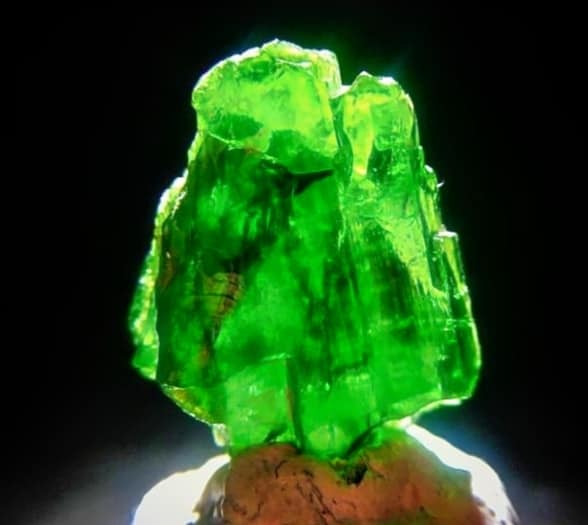
Chrome Diopside
Chrome diopside is an olive to neon green colored gemstone. It’s part of the pyroxene mineral group and is known for its vibrant, dark green color caused by the stone’s traces of chromium.
Diopside is an affordable alternative to more expensive green gemstones like chrome tourmaline, emeralds, and tsavorites.
Properties:
- Mohs hardness: 5.5 – 6.5
- Vitreous – dull luster
- Specific gravity: 3.3
- Refractive index: 1.6 – 1. 7
Uses:
- Jewelry Making
- Specimen collections
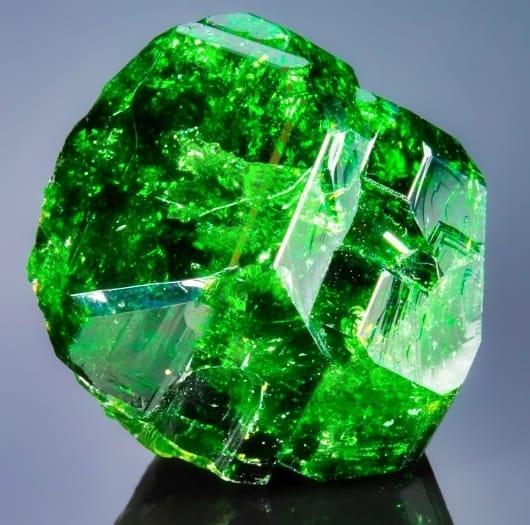
Chrome Tourmaline
This is a stunning gemstone when the crystal is highly transparent and the small traces of chromium and vanadium cause a vibrant green color. A lot of gem dealers talk about or label their tourmalines chrome green but a real chrome tourmaline is fairly rare, especially in larger sizes.
If you can afford it, this is a must-have in your crystal collection.
Properties:
- Mohs hardness: 7.0 – 7.5
- Specific gravity: 3.0 – 3.2
- Density: 2.82 – 3. 32
- Vitreous luster
- Double refractive
Uses:
- Jewelry application
- Specimen collectors

Emerald
The beautiful green-to-blue-green gemstone has been prized since antiquity. Emerald is a variety of the mineral beryl and is often found in a deep, lush green color. Its color is caused by trace amounts of chromium and sometimes vanadium.
Properties:
- Mohs hardness: 7.5 – 8
- Vitreous luster
- Specific gravity: 2.8
Uses:
- Used in Jewelry
- Specimen collectors
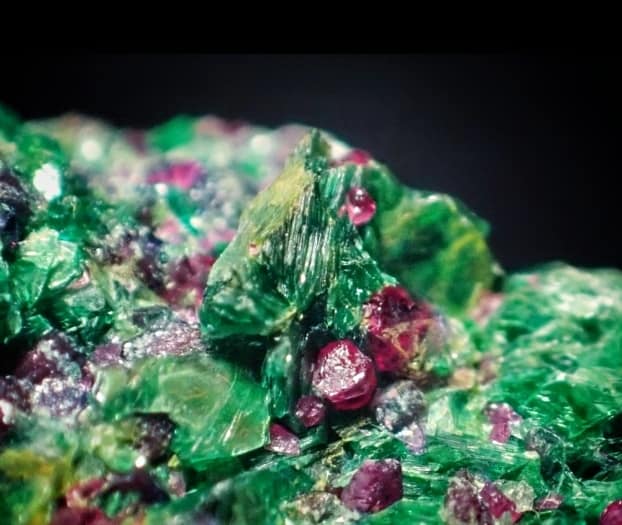
Fuchsite
Fuchsite is a green variety of the mineral muscovite and is a member of the mica group. It’s created through crystallization, and its green color is due to the presence of chromium.
Fuchsite is typically found in shades of green and is often found in association with quartz, feldspar, ruby, and tourmaline.
Properties:
- Mohs hardness: 2.5
- Uneven fracture
- Vitreous – pearly luster
- Specific gravity: 2.98 – 2.9
Uses:
- Ornamental carvings
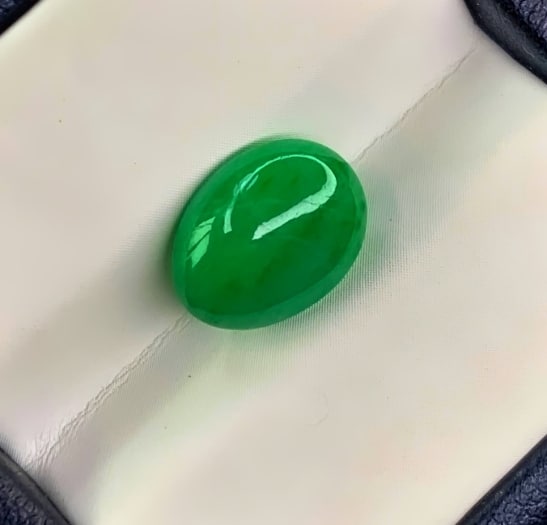
Jade
Jade contains jadeite, a vivid, deep green mineral. It’s found worldwide and prized by collectors originating from southeast Asia. It is one of the most durable stones and that is why it’s on my list of favorite green minerals. If you ever have an opportunity to see and touch ultra-high-end Jade then I recommend you take the opportunity. When holding this gemstone you’ll notice you want to stare at it for extended periods of time.
Properties:
- Mohs hardness: 6 – 7
- Splintery fracture
- Brittle tenacity
- Specific gravity: 2.9 – 3.4
- Refractive index: 1.6 – 1.7
Uses:
- Jewelry
- Carvings

Malachite
The stunning green Malachite consists of copper carbonate hydroxide mineral. It’s formed through the alteration of copper ore and is found in all sorts of shades of green, ranging from light to dark, and is often banded in various colors. Its green color represents growth, renewal, and fertility, making it a popular choice for those looking to bring balance and harmony into their lives.
Properties:
- Mohs hardness: 3.5 – 4
- Specific gravity: 3.6 – 4
- Refractive index: 2
- Adamantine – vitreous luster
Uses:
- Making jewelry,
- Carvings and sculptures
- Decorative items
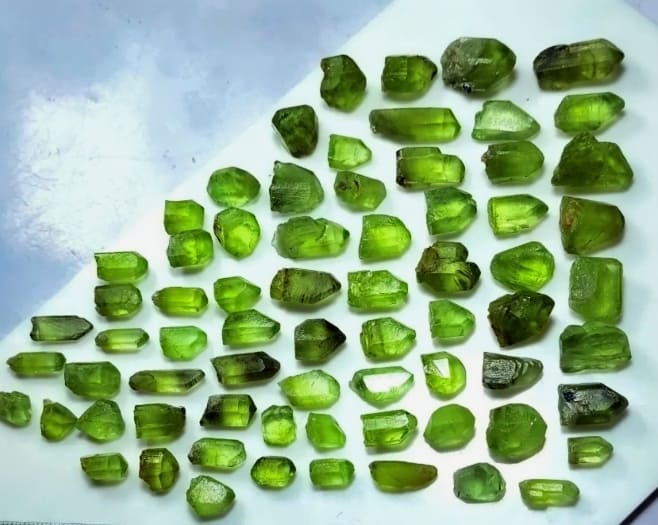
Peridot
You’ll find Peridot in volcanic basalt and igneous rocks. This beautiful lime-green gemstone is part of the olivine mineral group and is mostly used in jewelry. In my opinion, some of the highest quality peridots come from Afghanistan.
Properties:
- Mohs hardness: 6.5 – 7
- Vitreous – oily luster
- Refractive index: 1.64 – 1.70
- High melting point
Uses:
- Jewelry
- Specimen collectors

Serpentine
Serpentine is a group of minerals ranging from pale green to deep green and even black. It constitutes antigorite, lizardite, and chrysotile minerals.
Due to its beautiful color and durability, serpentine is often used in jewelry. Additionally, its unique aesthetics make it a perfect material for decorative pieces.
Properties:
- Mohs hardness: 3.5 – 4
- Greasy – vitreous luster
- Specific gravity: 2.2 – 2.9
- Brittle fracture
Uses:
- Hardstone carvings
- Construction of building materials
Common and Rare Green Rocks and Minerals
Green rocks and crystals are an exciting and diverse group of minerals sought after by rock hounds, jewelry manufacturers, and commercial entities. Whether you’re looking to add a unique piece of jewelry to your collection or a rare crystal to your specimen collection, green minerals are a must-have.
With so many possibilities, it is no wonder that green rocks and minerals have been treated as treasures for centuries.
- Identify Enstatite - March 12, 2024
- Identify Cerussite - March 3, 2024
- Identify Bytownite - February 18, 2024

20 Responses
I have a crystal I am having difficulty identifying and would like to send a photo.
Amandah – I emailed you directly
Jerred can you please contact me if you get time?
I have some green stones I need help with and a couple more.
I actually have some pretty interesting stuff that I can’t figure out.
Thank you!
I’ll email you directly
Hi I have some stone pictures I’d like to send if that’s ok.
I emailed you directly
Jerred hi I’m just old turkey out metal detecting all the time on old mountain trail I found some rocks I can pick up with magnet and found and area say hundred by hundred ft green old copper look I will have in hand on may 6 th anyway can you identify what I found if bring to you Ty Ed
Ed – I’d be happy to help out. When you have the rocks, take a couple of photos and email them to me.
I have quite a few rocks of the same type rock I keep finding in my driveway and I can not identify them, could you maybe look at a few pictures and help me please?
Krista – Thanks for reaching out and I’d be happy to help identify your stones.
I’ll email you directly.
Jerred….I recently bought a slice of striped rock ….thin, about 4 x 4″. It has a matte finish with shades of green. I failed to write down the name but heard the vendor say it started with a W.
Any idea what I have ? I plan to give it to my granddaughter. Thank you.
Carol Ann
Carol – I emailed you directly
Hi! I recently found a lovely green rock on our honeymoon. Probably nothing special, but maybe you can help me ID it?
Beth – Happy to help. I’ll email you directly.
A friend has found an unusual rock l, could you take a look. Please.
I emailed you directly
I found a rock I need help identifying can you help me out please?
Melissa – I emailed you directly
Hi, Jared–I have three sets of green rocks, and I believe I have two of them identified, but not sure of the third at all and not 100% confident on the others; can you help with this?
Happy to help and you might want to join my newsletter. It gives you unlimited access to me which means I can ID and value your stones at no cost.
I’ll email you directly.